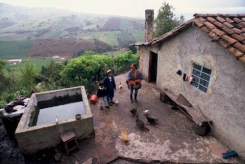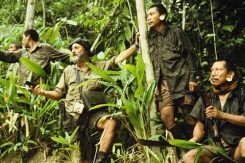Peru Releases Dramatic Footage of Uncontacted Indians
October 28th, 2011
The Peruvian government has released dramatic new footage showing a near-encounter with a group of uncontacted Indians along a riverbank
by Scott Wallace
Posted to NationalGeographic.com
The Peruvian government has released dramatic new footage showing a near-encounter with a group of uncontacted Indians along a riverbank in the Amazon rain forest. The video was taken by travelers on the Manu River in southeastern Peru in recent months, according to officials from Peru’s Ministry of the Environment, who released the images on Monday.
In the video, travelers appear to be playing a game of cat and mouse with the naked tribesmen, drifting close to shore only to flee in panic in their motorboat as the natives approach. Some of the Indians brandish bows and arrows, and at one moment, one of them prepares to launch an arrow at the boat. The travelers are heard debating among themselves whether to approach, whether to back off, and if they should leave gifts of food or clothing on the shore for the Indians to take.
Officials said there have been multiple sightings in recent months of nomadic bands of Mashco-Piro Indians in the area of Manu National Park. Isolated Indians are known to travel extensively by foot during the dry season, now at its height, appearing along the riverbanks as they search for turtle eggs buried in nests along the sandy beaches of the western Amazon. But mounting pressure from logging crews, wildcat gold prospectors, and seismic teams exploring for oil and gas are flushing isolated indigenous out of the forests as well, according to Roger Rumrill, a special advisor to the Environment Ministry.
“There is very strong pressure on their territories,” Rumrill said.The video and other accounts of recent sightings and near-encounters prompted officials to issue a stern warning to those traveling along the rivers and backwoods of the Amazon to avoid forcing contact with isolated groups, for the safety of all involved. Travelers were also urged to refrain from leaving behind gifts of food or clothing, which could transmit devastating illnesses to immunologically defenseless isolated Indians.
In releasing the video on Monday, Peruvian officials noted a sharp turn in national policy toward the estimated 4,000-5,000 indigenous people living in near-complete isolation from the outside world, promising to adopt a series of measures aimed at bolstering protection for isolated indigenous tribes and those in the initial stages of contact. The previous government, led by ex-president Alan Garcia, had auctioned off vast tracts of the Amazon to oil and logging concessions. Elected with the broad support of Peru’s indigenous population earlier this year, the government of president Ollanta Humala is moving quickly to distance itself from the policies of its predecessor.
“The policy of this government is one of permanent inclusion of indigenous peoples, of commitment to their social demands, including territorial demands, education, and health care,” Rumrill said. “It’s diametrically opposed to the previous government.” Those words mark a dramatic departure from the Garcia administration, whose officials denied the very existence of uncontacted nomads in the pristine rainforest regions opened up to development in the past few years. One state oil executive famously likened the elusive natives to the Loch Ness monster, claiming them to be a phantom concocted by environmentalists to hold back development.
Carlos Soria, the newly appointed secretary general of the National Service for Protected Natural Areas (SERNANP), the agency with jurisdiction over Peru’s national parks, said the government was in the process of updating protocols and recommendations for how best to deal with unexpected contingencies arising from contact with isolated indigenous populations. All new policy decisions would be guided regarding the isolated tribes, said Soria, by a commitment to better environmental management, a respect for human rights, and a “fulfillment of our obligations to our indigenous populations.”






























Scott, you have for the 2nd time amazed me. I love your site, informative,riveting. You have been well traveled. I regret your stay was so limited. Loved the bat, not so sure you did not bring as a prop. Forget the comment on your email re: glasses. Some people will go to lenghts to meet someone like you. My reply is WOW great site.
Thanks, and sorry it took so long to respond! Wishing you all good things.